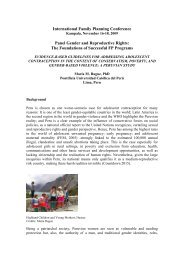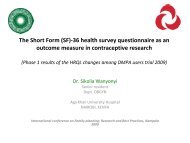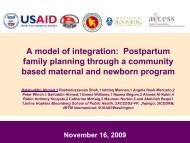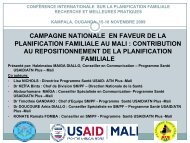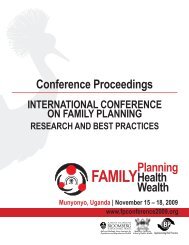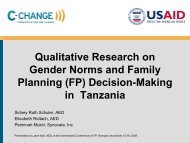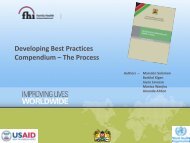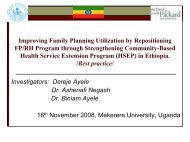Quality Assurance Evaluation of Sino-implant (II): a low-cost safe ...
Quality Assurance Evaluation of Sino-implant (II): a low-cost safe ...
Quality Assurance Evaluation of Sino-implant (II): a low-cost safe ...
You also want an ePaper? Increase the reach of your titles
YUMPU automatically turns print PDFs into web optimized ePapers that Google loves.
<strong>Quality</strong> <strong>Assurance</strong> <strong>Evaluation</strong> <strong>of</strong><br />
<strong>Sino</strong>‐<strong>implant</strong> (<strong>II</strong>): a <strong>low</strong>‐<strong>cost</strong> <strong>safe</strong><br />
and effective contraceptive<br />
<strong>implant</strong><br />
David Jenkins, PhD<br />
Aida Cancel, PhD<br />
Markus Steiner, PhD
<strong>Sino</strong>‐<strong>implant</strong> (<strong>II</strong>)<br />
•<br />
•<br />
•<br />
•<br />
•<br />
•<br />
•<br />
Two rod system with 75 mg levonorgestrel in each rod<br />
Made <strong>of</strong> medical grade silastic<br />
Dimensions: 2.4 mm x 44 mm<br />
Shelf‐life: up to 4 years<br />
Manufactured by Shanghai Dahua Pharmaceutical Co., Ltd.<br />
Registered in China (1994), Indonesia (2002), Sierra Leone<br />
(2008) and Kenya (2009)<br />
Tradename: Zarin®, Trust®, Femplant®
<strong>Sino</strong>‐<strong>implant</strong> (<strong>II</strong>) Activities<br />
•<br />
•<br />
•<br />
<strong>Quality</strong> <strong>Assurance</strong><br />
Registration<br />
Introduction Activities<br />
E02-2: Steiner et. al. Increasing access by introducing a <strong>low</strong>-<strong>cost</strong><br />
contraceptive <strong>implant</strong> in resource constrained countries
Research Purpose<br />
The purpose <strong>of</strong> this research was to conduct an<br />
independent evaluation <strong>of</strong> <strong>Sino</strong>‐<strong>implant</strong> (<strong>II</strong>) to<br />
provide assurance <strong>of</strong> the product quality and verify<br />
that it meets international quality standards.
<strong>Quality</strong> <strong>Assurance</strong> <strong>Evaluation</strong> Team<br />
FHI Team<br />
Markus Steiner, PhD <strong>Sino</strong>‐<strong>implant</strong> (<strong>II</strong>) Program Director<br />
David Jenkins, PhD Laboratory Manager, Product <strong>Quality</strong> and Compliance<br />
Aida M. Cancel, PhD Director, Regulatory Affairs and <strong>Quality</strong> <strong>Assurance</strong><br />
Eli Carter Director, Product <strong>Quality</strong> and Compliance Division (PQC)<br />
Consultants<br />
Eric Weichert, PhD President, Applications Specialists International<br />
Gary Gammerman, MS, JD President, Seraphim Life Sciences Consulting<br />
Partner Laboratories<br />
SGS Shanghai, China<br />
Nelson Laboratories Salt Lake City, UT<br />
Cyanta Analytical Laboratories Maryland Heights, MO<br />
Irvine Pharmaceutical Sciences Irvine, CA
<strong>Sino</strong>‐<strong>implant</strong> (<strong>II</strong>) <strong>Quality</strong> <strong>Evaluation</strong> Activities<br />
• Active ingredient (levonorgestrel)<br />
• Final product (<strong>Sino</strong>‐<strong>implant</strong> <strong>II</strong> rods)<br />
• Packaging material<br />
Packaging<br />
Material Tests<br />
Levonorgestrel<br />
Tests<br />
Final Product<br />
Tests
Standards and Specifications<br />
•<br />
Based on international or stringent regulatory<br />
authority standards<br />
• International Standards Organization (ISO)<br />
• United States Pharmacopeia (USP)<br />
• United States Food and Drug Administration (USFDA)<br />
• European Agency for the <strong>Evaluation</strong> <strong>of</strong> Medicinal Products<br />
(EMEA)/Committee for Proprietary Medicinal Products (CPMP)<br />
• American National Standards Institute (ANSI)/ Association for the<br />
Advancement <strong>of</strong> Medical Instrumentation (AAMI)
Tests and Results
Lot Release Verification<br />
•WS1‐(X‐281)‐2004Z Levonorgestrel Silastic<br />
Implants (<strong>II</strong>) approved by the State<br />
Pharmacopoeia Commission, China<br />
•Independently conducted by FHI (PQC, NC)<br />
and SGS (Shanghai)<br />
•10 lots <strong>of</strong> <strong>Sino</strong>‐<strong>implant</strong> (<strong>II</strong>) analyzed<br />
•All 10 lots <strong>of</strong> <strong>Sino</strong>‐<strong>implant</strong> (<strong>II</strong>) met lot release<br />
testing requirements<br />
•Independent commercial lot release testing<br />
<strong>of</strong> all commercial lots (except China and<br />
Indonesia) at SGS until 2013<br />
Standard: WS1‐(X‐281)‐2004Z<br />
Test Specification<br />
Identification Thin Layer Chromatograpy<br />
spot identification<br />
Assay (mg/set) 92.0‐108.0%<br />
Dissolution<br />
(Release Rate )<br />
80‐120 ug/set/24 h<br />
Sterility No evidence <strong>of</strong> growth
Levonorgestrel<br />
•3 lots tested from API<br />
manufacturer<br />
• All 3 lots met requirements for<br />
the USP Levonorgestrel<br />
specification<br />
Identification A<br />
USP(IR)<br />
Standard: USP Levonorgestrel<br />
Test Specification<br />
Infrared absorption spectrum is<br />
consistent with that <strong>of</strong> the standard<br />
Identification B Meets requirements for Specific Rotation<br />
and Melting range<br />
Melting range USP 232 – 239 oC Specific rotation USP ‐30o to ‐35o Loss on drying USP
Ethylene Oxide Residuals<br />
•Test to determine the concentration <strong>of</strong> ethylene oxide sterilization residues.<br />
Standard ISO‐10993‐7: Ethylene Oxide Residuals<br />
ISO ‐ (prolonged<br />
/permanent) ‐ 30 days<br />
Ethylene Oxide Ethylene<br />
Clorohydrin<br />
Ethylene Glycol<br />
60 mg 60 mg N/A<br />
ISO ‐ (lifetime) 2.5 mg 50 mg N/A<br />
FDA –Devices (ppm) 250 mg 250 mg 5000 mg<br />
•All 3 lots met requirements for the ethylene oxide residuals test specifications
Inorganic Impurities<br />
•<br />
•<br />
Evaluated <strong>implant</strong>s for the<br />
presence <strong>of</strong> 63 trace elements<br />
The entire rod content was<br />
evaluated<br />
•<br />
Based on USP USP General Chapter on Inorganic<br />
Impurities: Heavy Metals<br />
Test Acceptance Criteria<br />
Inductively Coupled Plasma<br />
Spectroscopy (ICP) with<br />
Mass Spectroscopy (MS)<br />
Inorganic impurities: heavy<br />
metal stimuli article (USP/NF<br />
2008‐04 )<br />
EMEA specification limits for<br />
residues <strong>of</strong> metal analysis<br />
(CPMP/SWP/QWP/4446/00<br />
corr Jan 2007)<br />
All 3 lots met requirements for the inorganic impurities acceptance criteria
Residual Solvents<br />
•Measures the amount <strong>of</strong> organic volatile chemicals that are present in the<br />
final product.<br />
Standard: Based on USP Organic Volatile Impurities<br />
Solvent Classification Specification<br />
Class 3: Solvents that should<br />
be used when practical<br />
Class 2: Solvents to be<br />
limited<br />
Class 1: Solvents to be<br />
avoided<br />
Ethanol 50 mg or less per day<br />
Ethyl acetate 50 mg or less per day<br />
Hexane 2.9 mg or less per day<br />
None None<br />
•All 3 lots met requirements for the residual solvents test specifications
Endotoxin<br />
and Cytotoxicity<br />
• Tests to (1) evaluate the presence <strong>of</strong> bacterial endotoxins and (2) evaluate<br />
biological reactivity<br />
Test Standard Specification<br />
Pyrogenicity ANSI/AAMI ST72:2002/ USP 85 Limulus amebocyte<br />
lysate (LAL) endotoxin detection test ‐ device<br />
immersion<br />
Cytotoxicity AAMI/ISO10993‐5 Tests for cytotoxicity – in vitro<br />
methods/USP 87 Biological Reactivity Tests, In Vitro<br />
• All 3 lots met requirements for the Endotoxin<br />
Less than 20 EU per device<br />
Not greater than mildly reactive<br />
(Grade 2)<br />
and Cytotoxicity<br />
test specifications
Packaging <strong>Evaluation</strong><br />
Standard Test Specification<br />
Package Integrity ASTM F2096 Bubble emission test Bubble emission Absence <strong>of</strong> leakage<br />
Package Impurities USP Containers:<br />
Physicochemical tests‐ plastics<br />
Buffering Capacity ≤ 10.0 mL<br />
Nonvolatile Residue ≤ 15 mg<br />
Residue on Ignition ≤ 5 mg<br />
Heavy Metals ≤ 1 ppm<br />
• All 3 lots met requirements for the package integrity test specifications<br />
• One lot <strong>of</strong> the package material was evaluated and met requirements for the<br />
package impurities test specifications
Summary <strong>of</strong> <strong>Quality</strong> <strong>Evaluation</strong> Activities<br />
Year 1<br />
Test # Lots Results<br />
<strong>Quality</strong> Monitoring Activities<br />
<strong>Sino</strong>‐<strong>implant</strong> (<strong>II</strong>) : Lot release verification 10 Met requirements<br />
Annual <strong>Quality</strong> <strong>Evaluation</strong><br />
Levonorgestrel Lot release verification 3 Met requirements<br />
Ethylene Oxide Residuals <strong>Evaluation</strong> 3 Met requirements<br />
Metal Impurities <strong>Evaluation</strong> 3 Met requirements<br />
Residual Solvents <strong>Evaluation</strong> 3 Met requirements<br />
Bacterial Endotoxin Testing 3 Met requirements<br />
Cytotoxicity 3 Met requirements<br />
Package Integrity <strong>Evaluation</strong> 3 Met requirements<br />
Package Impurities <strong>Evaluation</strong> 1 Met requirements
Summary <strong>of</strong> <strong>Quality</strong> <strong>Evaluation</strong> Activities<br />
Year 2<br />
Test # Lots Results<br />
<strong>Quality</strong> Monitoring Activities<br />
<strong>Sino</strong>‐<strong>implant</strong> (<strong>II</strong>) : Lot release verification 3 Met requirements<br />
Annual <strong>Quality</strong> <strong>Evaluation</strong><br />
Levonorgestrel Lot release verification 3 Met requirements<br />
<strong>Sino</strong>‐<strong>implant</strong> (<strong>II</strong>): Lot release verification 3* Met requirements<br />
Ethylene Oxide Residuals <strong>Evaluation</strong> 3 Met requirements<br />
Metal Impurities <strong>Evaluation</strong> 3 Met requirements<br />
Residual Solvents <strong>Evaluation</strong> 3 Met requirements<br />
Bacterial Endotoxin Testing 3 Met requirements<br />
Cytotoxicity 3 Met requirements<br />
Package Integrity <strong>Evaluation</strong> 3 Met requirements<br />
Package Impurities <strong>Evaluation</strong> 1 Met requirements<br />
* Lot release verification for one <strong>of</strong> these lots was conducted a part <strong>of</strong> the quality monitoring activities
Conclusion<br />
•<br />
•<br />
•<br />
Dahua Pharmaceutical Co., Ltd. is capable <strong>of</strong> consistently producing an<br />
<strong>implant</strong> that meets international quality standards<br />
A baseline has been established on <strong>Sino</strong>‐<strong>implant</strong> (<strong>II</strong>) that can be used to<br />
evaluate the continued quality <strong>of</strong> the product<br />
A quality assurance program for <strong>Sino</strong>‐<strong>implant</strong> (<strong>II</strong>) has been established and<br />
will continue until 2013



